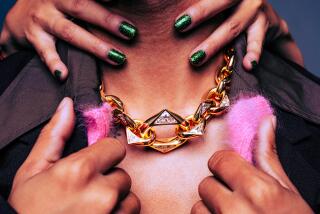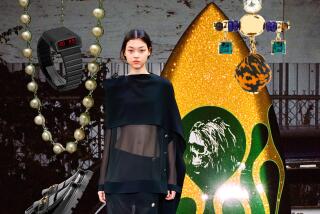Jewelry Moves Toward a Platinum Standard
- Share via
With award season well underway, all that glitters is not gold for stars such as Jim Carrey, Sandra Bullock and Salma Hayek. They are among the thousands of recent converts, celebrity and not, to platinum jewelry.
They love its understated luxury. It’s among the strongest and rarest of metals, and it doesn’t tarnish. What’s more, after more than half a century of gold fever, metal fans are charmed by its sense of newness over the yellow stuff.
As a result, they’ve made platinum the fastest-growing category of any fine jewelry, according to National Jeweler magazine, which says 1996 sales rose 60% for platinum; gold jewelry rose 2.8%.
The shift is most prevalent among young consumers heading to the altar. About 54% will consider platinum for their engagement and wedding bands, according to research recently released by Bride’s magazine. As many as 39% will make the plunge.
“Most of my girls prefer platinum to gold,” says celebrity uber stylist Phillip Block, who introduced Bullock and Hayek to the metal and frequently trims Carrey in vintage accouterments. “It’s clean, it’s light, it’s fresh. That’s ironic, because I mostly work with the antiquey stuff. But it still feels fresh because it’s platinum.”
Celebs and their stylists aren’t the only ones to hit platinum. The color and the label have caught on wherever trends count. As gray matters for another season, designers are calling fabrics platinum. Chanel has its Egoiste Platinum cologne.
In interiors, white metal madness extends to the rims of dishes and stemware and to wire bread baskets and picture frames--gold only a decade ago. Accessories and furnishings for home and office gleam in chrome, pewter and stainless steel.
Gold is gauche. Passe. So ‘80s.
“Platinum is driving the resurgence of white metals in general, with silver and white gold benefiting. It’s the hottest trend to hit the jewelry industry in years,” says Lynn Ramsey, president of the nonprofit Jewelry Information Center. “It’s changing the face of the industry and the face of the modern jewelry store.”
To the industry, the face of platinum has slightly sharp features softened by wide eyes and a Crest smile and belongs to Laurie Hudson. She is the president of Platinum Guild International USA Jewelry Inc. (PGI), the marketing extension of the metal’s international producers.
Industry experts also call her a maverick.
From her base high up a mirrored (platinum-like) tower in Newport Beach, Hudson has managed to multiply the number of U.S. retailers carrying platinum from 100 to 15,000 in six years. She has influenced engaged couples and other consumers with a multimillion-dollar advertising and education blitz and swayed dozens of designers to trade in gold for the new standard.
“This really happened because Laurie took a fairly simple message and hit the industry with big, stylish fashion shows, ads and seminars,” says National Jeweler magazine’s chief editor, Whitney Silaf. “There aren’t a lot of charismatic leaders in the jewelry industry, but Laurie Hudson has become a force. She got the public interested, and she got retailers and designers to play ball. Once they did, there was a game.”
Hudson relies on a team of 10 and a budget that’s jumped from $1 million to $15 million. A major slice goes to advertising, particularly in women’s magazines. There were 150 pages of ads in 15 publications last year, as well as regional TV and radio spots.
Industry observers point to the success of those ads: first, by reaching young women through bridal magazines, and then by featuring anonymous real people--long before the “real people” trend caught on in advertising. The campaign now includes better-known “real women” such as Olympic skater Kristi Yamaguchi.
A Web site (https://www.preciousplatinum.com) and toll-free phone line ([800] 990-PLAT) fielded more than 120,000 requests in 1998 from customers wanting to find stores in their area or to learn more about a metal that only seemed to occupy their great grandmother’s jewelry box.
While it never fell out of fashion at high-end retailers such as Cartier or Tiffany & Co., platinum lost store real estate when the U.S. government banned its use for anything but strategic purposes during World War II. (Platinum, even now, has a wide range of commercial and industrial uses, from automobile catalytic converters to nuclear reactors to cancer-fighting drugs.)
By the time the war ended, gold claimed victory. Perhaps this was only history repeating itself. The Spanish conquistadors, who dubbed this strange metal used by the Incas “platina”--meaning “little silver”--because of its look, apparently dumped hordes of what they found into the sea, alarmed that it would undermine the value of silver. Later they would replace lead with it for gunshot.
Its more aesthetic attributes emerged centuries later in the mid-1800s when artisans developed methods to alloy the metal and make it workable. (Platinum has 5% to 10% alloys, making it the purest of metals.) Through the Victorian and Art Deco eras, elaborate, lace-like designs became the rage. As this century closes, those vintage pieces are heirlooms sought by family members and antique collectors.
Yet, as far as its future, platinum’s worldwide producers recognized that it would take more than Japan’s dedicated patronage and Europe’s healthy interest to maintain its survival. It needed the U.S. market.
The group phoned Hudson, who at the time was in her 10th year as director of marketing and public relations at the Los Angeles-based American Gem Society. It was Elizabethan literature at UCLA--not public relations--that Hudson studied, but she ended up in PR after assorted jobs.
She convinced herself and her new bosses she could do the job near her Orange County home.
Her industry friends were another story. They thought it was bad enough she was trying to revive interest in a metal no one apparently wanted, let alone doing it outside a major metropolis.
Within months of starting the first ad campaign brandishing PGI’s toll-free number, Hudson was listening to consumers who were searching for suppliers and complaining that retailers were telling them to settle for white gold.
“Jewelers complained that [platinum] was too expensive. Designers said it was too hard to work with,” recalls Hudson, who lives with her husband of six years and their 2-year-old daughter in Tustin Ranch. “I told them, excuse me, that’s its cachet.”
Hudson organized classes attended by top jewelry designers. She hired certified technical expert Jurgen Maerz to develop curriculum for classes at the Fashion Institute of Technology in New York and the Gemological Institute of America. To encourage a new generation of designers, she established PGI-funded scholarships.
One designer, Michael Bogosian, made the switch in 1993 after attending a seminar. He traded in 25 years of gold experience, equipment and materials. The result: awards from his peers and a prestigious clientele flocking to his Studio City Michael B. shop for his platinum creations.
Bogosian believes the appeal is a matter of simplicity. “When you use the best, you don’t have to say much. Besides, you don’t take polyester to the finest tailor. Why would you set your diamonds in anything else?”
Platinum holds diamond settings more securely. The prongs of gold rings holding better diamonds are often platinum too.
Despite platinum’s skyrocketing growth and impact on fashion, gold has not lost its luster among the general population. Gold’s $13 billion in sales outweighs the $400 million slice platinum claims, says Silaf. Part of the reason is platinum’s rarity and cost.
Why so pricey? It takes 10 tons of ore to mine a single ounce of platinum versus the 3 tons to produce 1 ounce of gold. Prices fluctuate daily, but an ounce of gold is about $287 and an ounce of platinum is $355.
Next to platinum’s deep, rich luster, sterling silver has a dull, white finish and white gold looks yellow. You can also feel the difference: platinum is heavier.
“It’s really a connoisseur[‘s] piece of jewelry,” says Hudson. Platinum designers, in fact, consider themselves the couturiers of the jewelry industry.
Platinum’s cachet has attracted attention among a new generation of consumers raised to believe that the finer things in life are accessible.
Among PGI’s latest missions: to promote the metal among the middle-class and the younger set. Lighter and smaller pieces mean they are more affordable--as low as $200. Jewelry stores have stocked up on the affordable platinum sparklers for Valentine’s Day. Hudson says these have been “lightened up but not watered down.” Designs that are not diamond-intensive also have a lower price.
“This is a consumer-driven phenomenon. Consumers demanded better quality jewelry,” says Hudson, who also lists on her agenda a discussion with the Olympic folks about a platinum medal.
“Gen-Xers especially are turned off by the hype. I think the fact that platinum is pure and it’s rare and, well, it has this functional aspect to it--that’s why they want it,” she adds.
Hudson prefers to be seen as an individual who nudged--rather than led--a change in fashion and buying habits. “I know it’s not brain surgery. But I say, hey, it’s curing cancer. And when it comes to beauty and strength, there’s nothing like it.”






